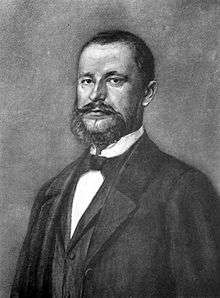Miloš Milojević

Miloš S. Milojević (1840–1897) was a Serbian lawyer, writer and politician. His work has been described as "at a ridge between history and literature", mostly for his travel-recording genre.[1]
Biography
Miloš S. Milojević, son of a parish priest, was born at Crna Bara (Bogatić) in Mačva, Serbia, on 16 October 1840. He graduated with a law degree from Belgrade's Grande École in 1862; studied philosophy, philology and history at the University of Moscow, from 1862 to 1865. Milojević returned to Serbia in 1866, worked for the government judicial system, and later taught at high schools in Valjevo, Belgrade and Leskovac.
He died at Belgrade on 24 June 1897. He was buried in Novo Groblje.
Historiography
.jpg)
In 1887 his old fashioned approach to historiography was challenged and debated by Ilarion Ruvarac and Ljubomir Kovačević and eventually proved erroneous through critical methods, though not all of his scholarship was marred by their victory. He travelled to the Kosovo and Metohija region in 1871-1877 and left three volumes of data and maps which testify that Serbs were the majority and Albanians the minority population. His demographic-statistical structure, however, matched an independent census taken by the Austrian authorities at about the same time. Because of his ideas about Greater Serbia and Serbisation, he is also known as Mad Milosh in Bulgaria.[2][3][4] The map included not only today Bulgaria, but also present day Albania, Kosovo, Macedonia and Northern Greece.[5]
Works
- Odlomci istorije Srba i srpskih - jugoslavenskih - zemalja u Turskoj i Austriji, Beograd, 1872.
- Pesme i običaji ukupnog naroda srpskog
- Putopisi dela prave - Stare Srbije
- Naši manastiri i kaluđerstvo
- Prva dečanska hrisovulja
- Druga dečanska hrisovulja
Translations from Russian
- Običaji velikorusa
- Maljuta Skuratov (in two volumes)
Manuscripts
- Putopise (in nine segments)
- Četvrta knjiga pesama i običaja
- Nemanjića
- Prizrenska tapija
- Pravila svete Petke paraskeve srpske
- Pravila svetom Simenu srpskom
- Opšti list iz Patrijaršije Pećske
- Odgovor na izmišljotine u 10 i 12 broju Budućnosti, pod imenom: Naša agitacija na istok
References
- ↑ Мирчета Вемић (1 September 2005). Етничка карта дела Старе Србије: Према путопису Милоша С. Милојевића 1871–1877. год. Geografski institut „Jovan Cvijić“ SANU. pp. 16–. ISBN 978-86-80029-29-0.
- ↑ Как бе посърбен Пирот
- ↑ Владимир Русков, Защо Народната библиотека "Св. св. Кирил и Методий" не "помни" нищо за Западните покрайнини?
- ↑ Iz arkhiva na Konstantin Irechek, Volume 1
- ↑ Ethnic Mapping on the Balkans (1840–1925): a Brief Comparative Summary of Concepts and Methods of Visualization, G. Demeter, Zs. Bottlik, Kr. Csaplár-Degovics, Hungarian Academy of Sciences, 2015, p. 85.